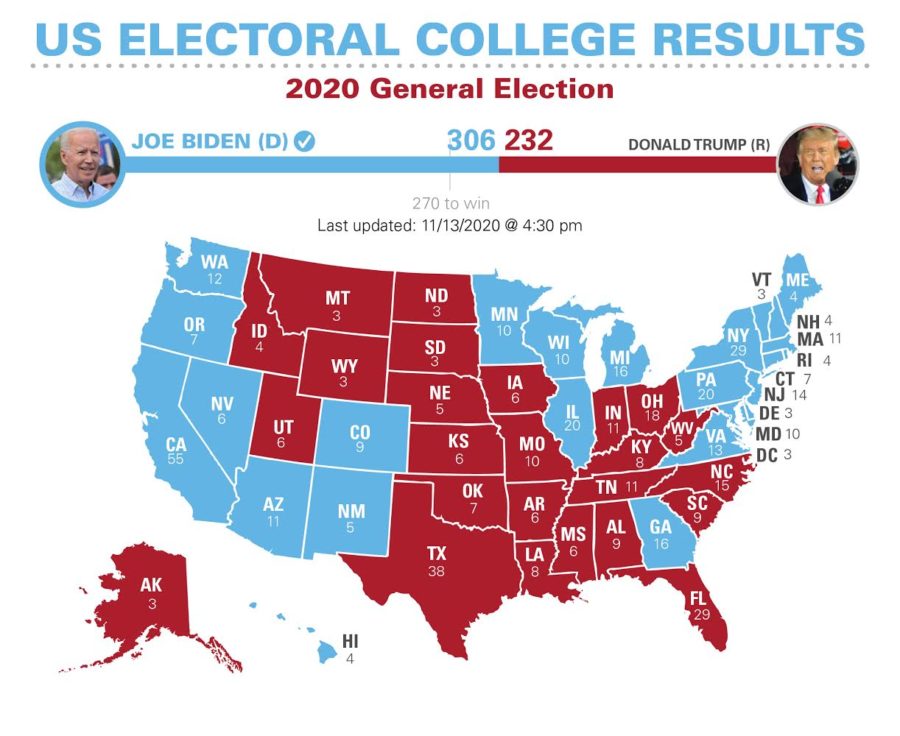Stacey Abrams helps Democratic Party flip Georgia in the presidential race
Almost two weeks after Election Day, President-Elect Joe Biden wins Georgia while President Donald Trump wins North Carolina.
November 15, 2020
A household name in Georgia helped President-Elect Joe Biden flip the state.
Stacey Abrams, former Georgia state House minority leader, aimed to be the first female African-American governor in the U.S. but lost the governor race in 2018. She spent the two years after helping new voters register and helping to stop the ongoing voter suppression in Georgia.
Even though the presidential race has ended, the work continues in Georgia as the two U.S. Senate races become runoff races. The runoff races will take place in January and will decide which party will hold the majority in the U.S. Senate.
Abrams lost the gubernatorial election to Georgia Secretary of State Brian Kemp by a small margin of 55,000 votes. Abrams filed a lawsuit against Kemp for voter violation during the governor’s race.
“[Kemp] had done an extensive, aggressive voter purging of voter rolls immediately before the election,” said Karen Kedrowski, director of the Carrie Chapman Catt Center for Women and Politics.
Abrams dedicated her attention to fighting voter suppression in Georgia and helping new voter registration.
Abrams’ efforts are being attributed to helping Georgia vote blue for the first time since 1992.
“When trying to flip Georgia, they couldn’t rely on the same people; they have to find new voters and people to vote Democratic,” said Mack Shelley, chairman and professor of political science. “Abrams was willing to talk to conservatives [and] white voters and convince them to vote Democratic.”
Abrams worked hard to recruit new Georgians, and she helped create an organization called the New Georgia Project, which focuses on those moving to the state, Kedrowski said.
Abrams also founded Fair Fight in 2018, an organization that fights against voter suppression.
Fair Fight is being credited in helping Georgia surpass the voting record. Roughly 5 million people voted in Georgia in 2020, compared to 4.1 million in 2016, according to the Georgia Secretary of State website.
“She worked very hard to make sure that the practices that are occurring in Georgia and elsewhere do not inadvertently lead to voter suppression,” Kedrowski said.
Fighting practices like voter purging right before the election and making sure officials know the correct voter ID for voters to have, Kedrowski said, were part of Abrams’ strategy, as well as voter outreach.
Abrams and her team have utilized door knocking to engage and register voters.
“When you’re trying to not only harness demographic changes but leverage low-propensity voters, you cannot simply hope that they’ll hear the message — you have to treat them as persuasion voters,” Abrams said in an interview with Politico before Election Day. “Only the message is not trying to persuade them to share Democratic values. Your message is to persuade them that voting can actually yield change.”
The demographics in Georgia are shifting. In 2019, Abrams and her former campaign manager wrote a 16-page document filled with details on Democratic voter shift in the state. It was described as the blueprint for victory in 2020.
“With a diverse, growing population and rapidly changing electorate, Georgia is not a future opportunity for Democrats; it is a necessity right now,” the document said. “Georgia is every bit as competitive as perennial battleground states. With one of the youngest and the most African American electorate of any competitive state, Georgia has demographic advantages that don’t exist in other states.”
The demographics in Georgia have shifted as the population has grown. More people are moving to urban areas and their suburban inner rings, Shelley said.
“The electorate is becoming younger as older voters die and younger ones take their place,” Shelley said. “The population growth rates are higher for major minority groups.”
The New Georgia Project said on its website the organization registers over 400,000 voters.
“The demographic shift has helped Democrats because the growing parts of the state’s population are heavily Democratic-oriented or politically independent,” Shelley said.
Abrams and Fair Fight have turned their attention to the Georgia Senate runoff races.
“The tactic to get rid of [President Donald] Trump might have helped get voters to turn out, but they don’t have that same tactic for the runoff races,” Shelley said. “It will be interesting to see if Abrams’ voter outreach works to Democrats’ advantage in January.”







